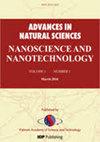Analyzing the role of Ni dopant to change the structural, optical and photocatalytic properties of SnO2 nanoparticles
IF 2.1
Q3 MATERIALS SCIENCE, MULTIDISCIPLINARY
Advances in Natural Sciences: Nanoscience and Nanotechnology
Pub Date : 2023-08-07
DOI:10.1088/2043-6262/acebd7
引用次数: 0
Abstract
SnO2 and 5 wt% Ni doped SnO2 nanoparticles (SnO2:Ni NPs) were successfully synthesised by a template-free hydrothermal method. X-ray diffraction (XRD) patterns depicted polycrystalline nature of the NPs in rutile-type cassiterite phase with dominant (110) and (101) Bragg diffraction peaks. Rietveld refinement of XRD patterns supported single phase tetragonal crystal structure having space group P42/m n m. With Ni doping, crystallite size of NPs decreased from 39 nm to 35 nm whereas lattice strain increased from 3.56 × 10−3 to 3.99 × 10−3. This is attributed to the substitution of Sn4+ ion by Ni2+ ions. The morphology of the SnO2 NPs also changed from regular spherical shape to elongated irregular shape upon Ni doping. The dominant Raman peak obtained at 634 cm−1 matched with the signature peak for rutile SnO2 (Raman A1g mode). Further, we observed disappearance of E g mode due to Ni doping, which indicated the formation of oxygen vacancies. Also, XPS analysis indicated an increase of oxygen vacancy concentration in the doped NPs due to charge imbalance between Sn4+ and Ni2+. The direct optical band gap of SnO2 increased from 3.97 eV to 4.11 eV when doped with 5 wt% Ni and it is ascribed to Burstein–Moss effect. Irrespective of higher optical band gap of SnO2:Ni NPs, they showed enhanced photocatalytic activity to degrade Rhodamine B (RhB) dye molecules under UV-visible irradiation. The first order kinetic reaction rate constants for degradation of RhB were found to be 0.014 min−1 and 0.045 min−1 in case of SnO2 and SnO2:Ni NPs respectively. The enhanced photocatalytic activity in SnO2:Ni NPs is explained by relating to the formation of more oxygen vacancies and chemisorptions of O2 and H2O molecules followed by generation of radicals. This work demonstrates the superiority of SnO2:Ni NPs for use as photocatalytic material for industrial waste water treatment.分析Ni掺杂对SnO2纳米颗粒结构、光学和光催化性能的影响
采用无模板水热法成功合成了SnO2和5wt % Ni掺杂的SnO2纳米粒子(SnO2:Ni NPs)。x射线衍射(XRD)图显示了金红石型锡石相中NPs的多晶性质,并以(110)和(101)布拉格衍射峰为主。XRD谱图的Rietveld细化支持具有空间群P42/m nm的单相四方晶体结构。Ni掺杂后,NPs的晶粒尺寸从39 nm减小到35 nm,晶格应变从3.56 × 10−3增加到3.99 × 10−3。这是由于Sn4+离子被Ni2+离子取代所致。Ni掺杂后,SnO2 NPs的形貌也由规则的球形变为细长的不规则形状。在634 cm−1处获得的优势拉曼峰与金红石SnO2的特征峰(拉曼A1g模式)相匹配。此外,我们观察到由于Ni掺杂导致的E - g模式消失,这表明形成了氧空位。此外,XPS分析表明,由于Sn4+和Ni2+之间的电荷不平衡,掺杂的NPs中氧空位浓度增加。当掺杂5 wt% Ni时,SnO2的直接光学带隙由3.97 eV增加到4.11 eV,这归因于Burstein-Moss效应。尽管SnO2:Ni NPs的光学带隙较大,但在紫外可见照射下,它们对罗丹明B (Rhodamine B, RhB)染料分子的光催化活性增强。在SnO2和SnO2:Ni NPs中,RhB降解的一级动力学速率常数分别为0.014 min−1和0.045 min−1。SnO2:Ni NPs的光催化活性增强与形成更多的氧空位和O2和H2O分子的化学吸附以及自由基的产生有关。本研究证明了SnO2:Ni NPs作为光催化材料用于工业废水处理的优越性。
本文章由计算机程序翻译,如有差异,请以英文原文为准。
求助全文
约1分钟内获得全文
求助全文
来源期刊

Advances in Natural Sciences: Nanoscience and Nanotechnology
NANOSCIENCE & NANOTECHNOLOGYMATERIALS SCIE-MATERIALS SCIENCE, MULTIDISCIPLINARY
自引率
4.80%
发文量
0
 求助内容:
求助内容: 应助结果提醒方式:
应助结果提醒方式:


